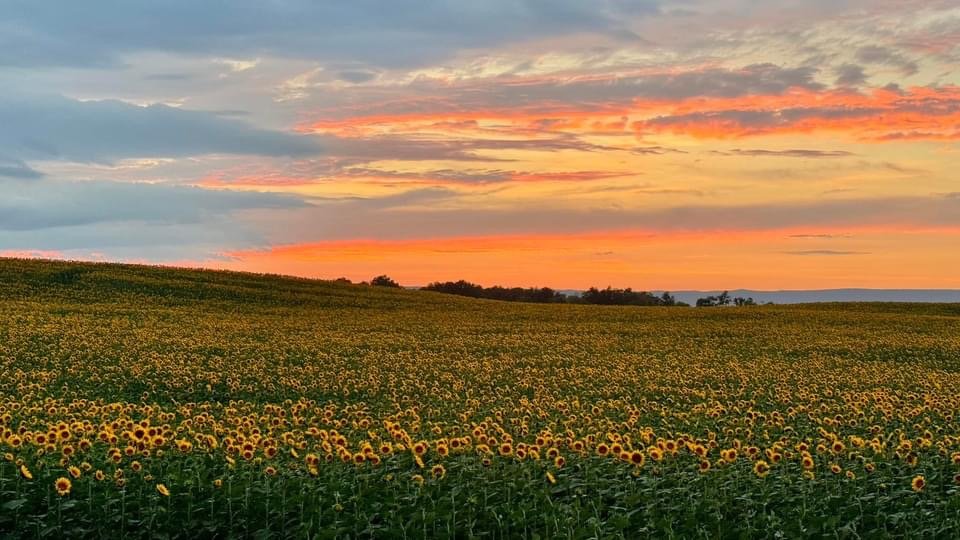Sunflowers Everywhere
You can’t miss their bright sunny faces smiling at you in many of the market stalls these days as we are in the thick of sunflower season. They’re the grand finale in the fireworks show of summer colors. Vendors grow an assortment of sizes, shapes, and colors, many of which have been specifically bred for cut flowers.
Did you ever get a bouquet of sunflowers only to have them drop crumbs of pollen all around the vase? Or worse yet, stain grandma’s favorite linen tablecloth? Flower breeders have worked for decades to create colorful blooms that don’t shed pollen along with varieties with colors that deviate from the norm.
But did you know that commercial crop farmers also grow sunflowers for uses other than interior decoration? Actually, before the advent of cultivation wheat, corn, and soybeans on a large scale sunflowers were the crop of choice for making flour, for both human and animal consumption, and for pressing oil for use in cooking.
No matter where I drive in my neighborhood or within the county right now, I’ll eventually pass a large planting of black oil sunflowers. These are the small, solidly colored seeds one most often finds in bird feed are too small for humans to crack open and snack upon, but just right for the nimble little beaks of birds. Some are sold for oil pressing and increasingly, they are being used in livestock feed often as a replacement for soy beans.
Most of the commercial sunflowers are grown in North Dakota which boasts over a billion pounds in production annually, but in recent years their plantings have increased as local farmers look for more sustainable (and profitable) crops to grow that can withstand our changing environment.
Like wheat, beans, and corn, sunflower seed gets drilled into the ground to keep it from being scavenged by wildlife. A grain drill is a piece of equipment that lets farmers plant seeds at a specific depth and spacing in neat rows. They’ve been around for millennia, being documented as far back as 2,000 BC in Mesopotamia.
There are a number of reasons farmers have added sunflowers to their crop rotations. First, there is no such thing as a GMO sunflower, unlike wheat, corn, and soybeans. As more consumers are demanding nonGMO foods and meats from livestock who are not fed GMO feedstock, farmers have sought out alternatives to usual commodities.
The fast-growing tall stalks can outcompete with weeds so they don't require herbicides. They are also allelopathic, which means they produce their own compounds that repress the growth of other plants around their roots. They attract a plethora of pollinators—a huge plus--so pesticides is out. Chemicals are costly to purchase and time-consuming to apply so for the farmer it’s a winning solution.
Sunflowers are also extremely economical to plant. With the size of the seeds and spacing requirements, you only need 5 pounds per acre. To contrast, wheat seed can take as much as 125-pounds an acre and soybeans use 75-pounds an acre. A 50-lb bag of sunflower seeds costs around $30, while a genetically modified and patented sack of seed can run as much as $200 for the same size bag. This adds up when a 20 or 40 acre field is being planted.
Because sunflowers have deeper roots than traditional row crops their roots draw both moisture and nutrients from deeper in the soil. They are drought tolerant, requiring less water than wheat, corn, and soybeans so in a dry year (like this year) farmers who planted sunflowers are going to still get a good return despite having less regular rainfall. And when the rains come in a deluge, those thick stalks can withstand it.
Sunflowers are also known for their abilities to detox soils which makes it a great crop for farmers transitioning from conventional to organic methods. Ukraine, which is famous for their iconic sunflower fields has successfully used sunflowers to mitigate radiation and heavy metal contaminants in their lands.
Sunflowers aren't a single flower, but lots of little flowerets, with as many as 2,000 per stalk. There are over 70 different varieties of sunflowers grown throughout North and South America. Sunflowers are also nature's sundials, their colorful disks following the sun as it moves across the sky.
Like the colorful fall leaves of New England, the massive fields of sunflowers are drawing peepers from all over the region for photo opportunities. (Lesher’s in New Franklin has the best spot for those who want to park and walk around)
And me? I feel mighty fortunate that the sunflowers have become a part of my daily life be it in the fields of my neighbors, in the feed for both livestock and wildlife here on the farm, and yes, if there’s any leftover on Sundays after market I’ll snag a bouquet to brighten my home.

